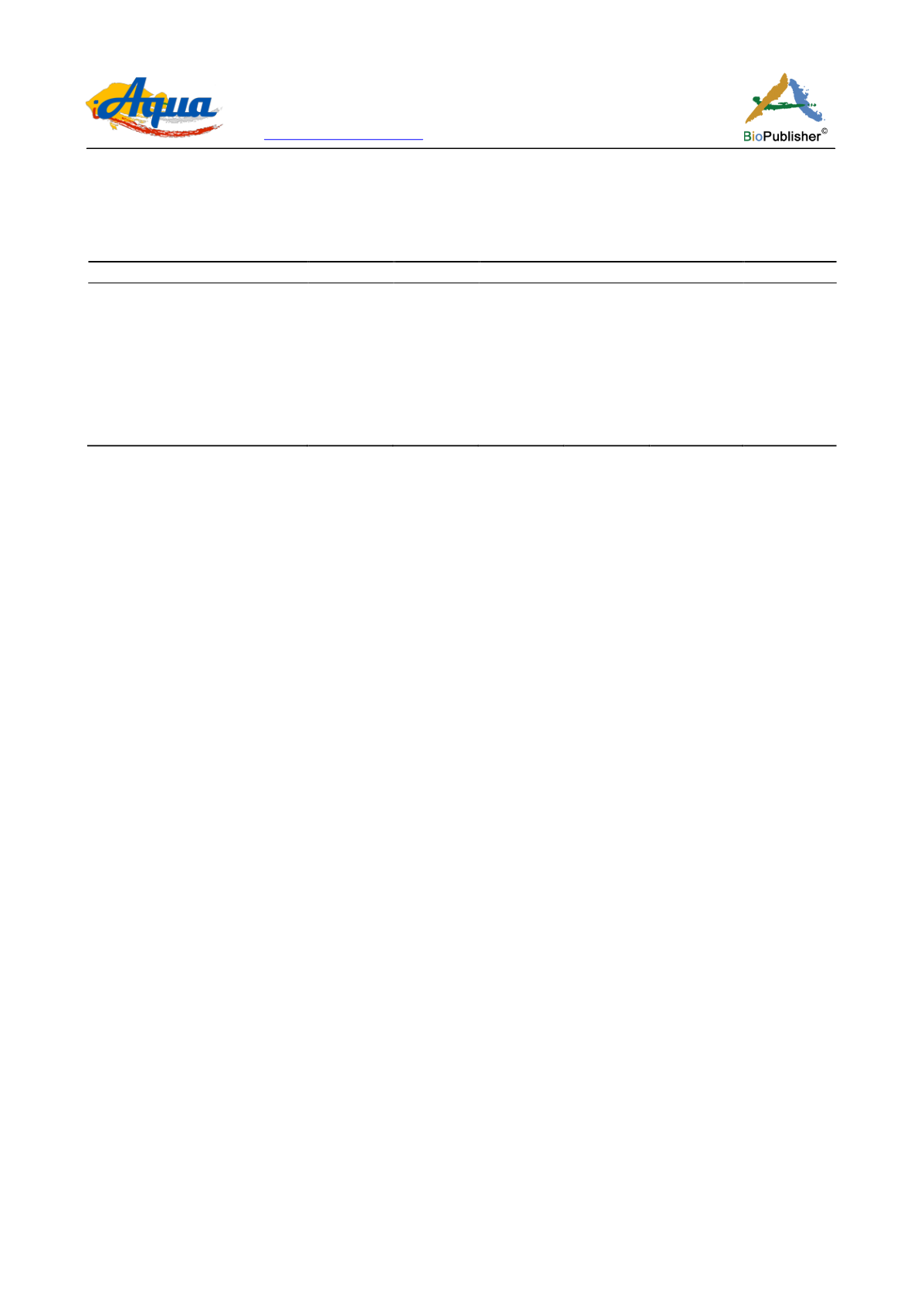
International Journal of Aquaculture, 2017, Vol.7, No.6, 42
-
50
47
and dietary energy supply of catfish (Fagbenro and Arowosoge, 1991). Furthermore, it also implies that the
experimental diets contained anti – growth factors or that
Clarias gariepinus
was highly sensitive to the active
components of the plants at higher inclusion
s
.
Table 3 Production Economics of
Ocimium gratissimum
meal experimental diet
Parameters
OGM1
OGM2
OGM3
OGM4
OGM5
OGM6
Cost of feeding (N)
65.67
89.28
86.63
76.34
48.28
49.72
Cost of fingerling (N)
300
300
300
300
300
300
Expenditure (N)
365.67
389.20
383.63
376.34
348.28
349.72
Value of fish (N)
330.80
504.17
478.09
421.26
83.83
75.86
Incidence of cost
2.35
2.23
1.93
2.41
120.7
146.24
Profit index
5.04
5.65
5.72
5.52
1.74
1.53
Net profit
-34.81
114.97
94.46
44.92
-264.45
-273.86
Benefit Cost Ratio (BCR)
0.905
1.30
1.25
1.12
0.24
0.22
Note: Mean are values of three replicates, N = Naira
The chemical composition of the essential of
O
.
gratissimum
can change accordingly with geographical
distribution and daytime of collection. Vincenzi et al. (2000) reported that estragole a naturally occurring
genotoxic carcinogen in experimental animals after chronic exposure or after a few repeated doses can be present
in
O
.
gratissimum
. The reduced total final weight gain, mean weight gain, protein efficiency ratio, feed conversion
ratio and specific growth rate, relative growth rate in tested
C
.
gariepinus
at ≥ OGM5 might not be unconnected
with the presence of this caricnogenic estragole in the
O
.
gratissimum
used in the present study. Although the
chemical components of the herb
O
.
gratissimum
was not determined to sanctify its usage in phytomedicines.
Furthermore, the reduction in live body weight of
C. gariepinus
beyond ≥ OGM5 were similar to Ogbuewu et al.
(2010) who reported similar reduction in the live weight of rabbit beyond 5% neem leaf meal (NLM) diet, which
implied a reduction in growth rate. It appears that these neem bioactive compounds are responsible for depression
in nutrient utilization and growth in rabbits. Similarly, the leaves of
O
.
gratissimum
have been repeated to contain
saponins. The effects of saponins might have contributed to the clinical signs of loss of appetite (as deduced by
reduction in feed intake) and loss of weight observed in all rabbits administered
O
.
gratissimum
extract Ephraim
et al. (2000).
Saponins are known to be toxic to body systems (Watt and Breyer-Brandwrijk, 1962; Edeoga et al., 2006).
Opdyke (1974) further reported that it is likely that the toxic potential of the
O
.
gratissimum
oil is due to thymol,
which is the major component with a P.O. LD of 3.75-5.67 g/kg weight body weight. The feed intake, mean feed
intake, total protein intake and mean protein intake varied significantly within the group of fish
fed OGM’s diet
when compared with the control. There were reduction in all these parameters in fish fed ≥ OGM5 diets; this
might be due to higher concentration of saponin at the higher inclusion levels, as observed by Effraim et al.
(2000).
The higher voluntary feed intake at ≥ OGM5 in the
C. gariepinus
were also similar to the reported increase in the
total quantities of tested neem leaf meal consumed by rabbit, which increased with the increasing concentration of
the neem leaf (T1 (0.0g), T2 (234.98 g) T3 (665.06 g) and T4 (1237.60 g)) respectively, but with attendant
reduction in body weight as the concentration of neem leaf meal increased.
The feed striking time and feed acceptability indices may not be significantly different (p>0.05) at the end of
feeding trial in both the fish fed
OGM’s tested group and the control diet, however, the numerical variation
observed for these parameters could be due to the varying levels of
O
.
gratissimum
leaf in the diets affecting the
palatability. The voluntary feed intake which is a function of acceptability, palatability and utilization (Mc Donald


